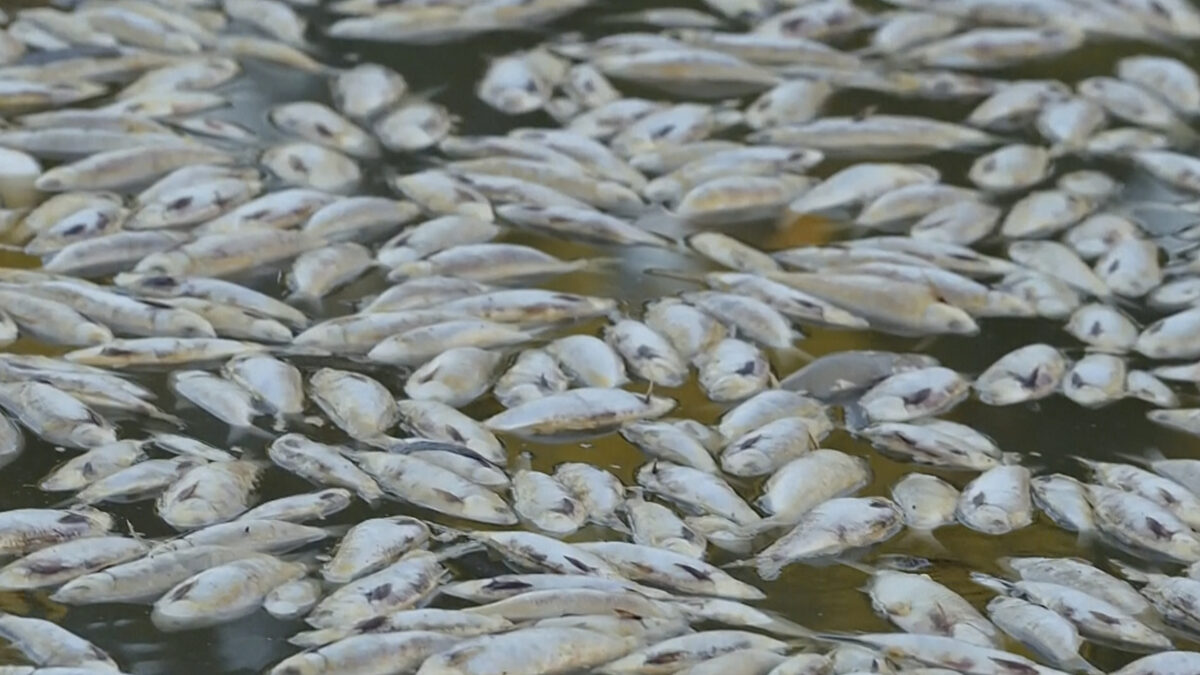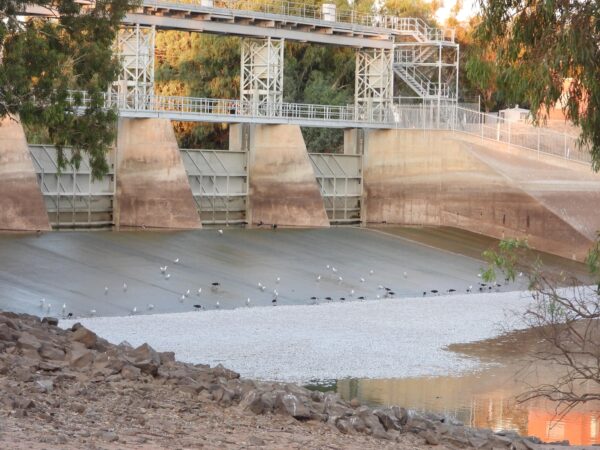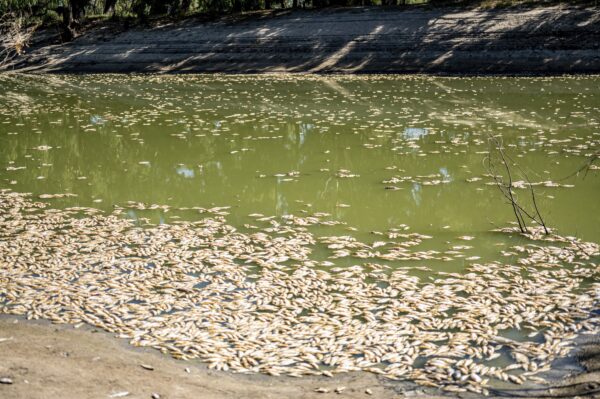


A royal commission into Australia’s arguably “worst” fishkill, which resulted in the deaths of millions of fish along the Darling-Baaka River in New South Wales (NSW), has been called on by the NSW Greens as investigators uncover missing crucial measurement equipment as a possible link to its causation.
Authorities estimate up to 20 million fish have died due to depleted oxygen levels in the river following prolonged flooding and repeated heatwaves in recent weeks. This incident has been reported to be worse than the one that occurred near the same location in 2018-2019 during a severe drought, where approximately one million fish were washed up dead.
NSW Greens MP, Cate Faehrmann, said in a March 22 statement that a royal commission would “shine a spotlight” on the NSW government and its departments, which the Greens say have contributed to the “decline” of the Murray-Darling Basin.
“This is the worst fish kill on record, but unless we urgently shine a spotlight on the departments that continue to make the same mistakes over and over, it will just be the worst yet,” Faehrmann said.
“The NSW government has ignored scientific advice, manipulated water sharing plans, undermined environmental flows, allowed illegal pumping and meter tampering, and wasted hundreds of millions on ineffective infrastructure projects.
“This fish kill is just the latest in an extended ecological catastrophe caused by decades of mismanagement, incompetence and special treatment of irrigators’ interests by successive NSW governments and their agencies.”
The NSW government’s department of planning and environment has been approached for comment, but The Epoch Times was deferred to the NSW’s Public Information Functional Area Co-ordinator (PIFAC).
Meanwhile, federal water Minister Tanya Plibersek said the Menindee fish kill was devastating for the Menindee community and for the environment. She also criticised the Coalition for not delivering “anything” on the Murray-Darling Basin Plan for the past nine years, saying that were it otherwise, “we would be in a better place now.”
“I have recovered more water towards the additional environmental water target in nine months than you did in nine years,” she said on March 22 during question time in parliament.
In February, Plibersek announced that the federal government would begin water buybacks from March in order to meet the 450 gigalitre target by the legislated deadline of June 2024.
Water gauges along the Darling-Baaka River in the vicinity of Menindee lakes were taken offline in November 2022 due to significant flooding, WaterNSW—whose role it is to operate the lakes—told The Epoch Times in an emailed statement.
As such, real-time river flow data was taken offline for months.
“The affected gauges needed to be recalibrated on-site to ensure accuracy before returning to service, a process that was delayed by the widespread flooding across the region, which restricted access to some sites,” a spokesperson for WaterNSW said.
However, the key monitoring gauge at Weir 32—which regulates river flow around the Menindee Lakes system—was only restored on March 13 after a million dead fish washed on the surface of the river.
The WaterNSW spokesperson told The Epoch Times that authorities were only alerted of the fishkill on March 17.
Maryanne Slattery, a former director of the Murray-Darling Basin Authority, said the missing measurements from the gauge may have contributed to the fish kill.
“When you are hearing rumours and theories about what happened at Menindee, the first thing I would do is go and have a look at the gauge data and see what releases were made out of Weir 32,” Slattery said, reported the Sydney Morning Herald.
“So the accusation is that the weir was closed, and the fish couldn’t escape the low-oxygen water; they were all looking to swim upstream.
“Now the data for all the direct measurements is all there on the website, but it doesn’t have the flow rate … Sometimes you might have a broken gauge, or it didn’t upload, but it is really weird to have all the direct measurements but not the flow rate.”
Professor of Environmental Science at UNSW, Richard Kingsford told The Epoch Times in an email that because of the engineering structure at Menindee, the fish couldn’t move upstream.
“The main reason (for the lack of oxygen) is because of the blackwater—where bacteria and other microbes break down the dead wood and branches in the river and floodplain, and then this went back into the main channel as the floodplain was drying along with the fish,” Kingsford said.
“Over many years, governments have allowed overallocation of the tributary rivers of the Darling River which means the flows are a lot less, and the small and medium floods that keep the river healthy have decreased.
“This means there is more dead wood on the floodplain, and so when there is a large flood like the 2022 one, then a lot more blackwater/or poor oxygenated water enters the river.”
Kingsford added that oxygen problems on the Murray River had existed previously but nothing to the extent seen recently.
“Many of the other inland rivers are healthy, and so fish can move up and down the rivers,” he said.
Kingsford said that water buybacks would help more environmental flows back into the river system but said that it would be very costly.
“There will be enough willing sellers for it to buy back water, but the water may be very expensive,” Kingsford said.
“We need to have more environmental flows in the river, the buyback will help to meet the target. We also need to understand how much water is going out at various times so we can manage the system to measure how much water there is at various times in the river.”
However, farming groups have argued against the move for water buybacks due to the potential for soaring prices, as well as community concerns over job losses.
Removal of the dead fish carcasses—many of the native bony herring, carp, Murray cod and golden perch varieties—began on March 23 evening after extensive delays in transporting heavy machinery from Sydney.
The operation is being led by NSW Police. Specialist contractors have also been called in to help, while Fire and Rescue NSW officers were using booms to move the dead fish to shore for disposal.
NSW Police Assistant Commissioner Brett Greentree said it would take some time to remove the 20 million dead fish.
“It’s an unprecedented scale now and a logistical nightmare,” Greentree told ABC’s RN Breakfast on March 22.
Menindee resident, Mick Clausen, said the cleanup had come too late and that the dead fish were already affecting the quality of the water reported The Guardian.
“All I can say is it stinks,” he said. “You wake up through the night, and it is hard to get back to sleep because all you do is smell decaying fish.
“They are all rotten, they are all sinking, and when I turned my pump on yesterday, you could smell it through the water, through the hoses; it stinks, and I think it’s too late.”
NSW police have reassured local residents that their drinking water was safe.
Meanwhile, Barwon MP, Roy Butler, said he supports an independent investigation into the incident, reported The Guardian.
“I think there needs to be an independent investigation to look at what has actually happened and [to] get to the bottom of those causes because there are theories running around that it is other things,” he said.
“[We need to] get to the bottom of what really happened with an independent person and then come up with a series of recommendations if we can to try and avoid this happening again.”


